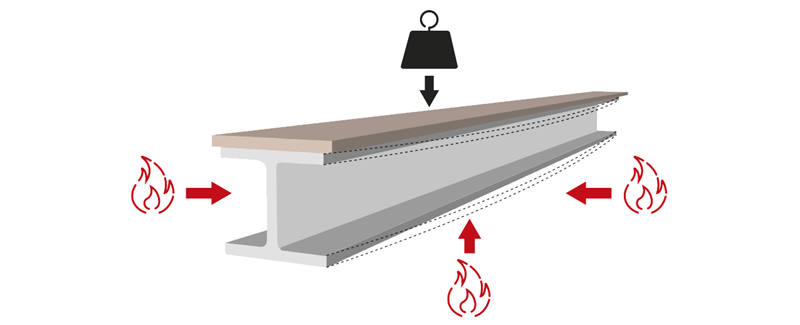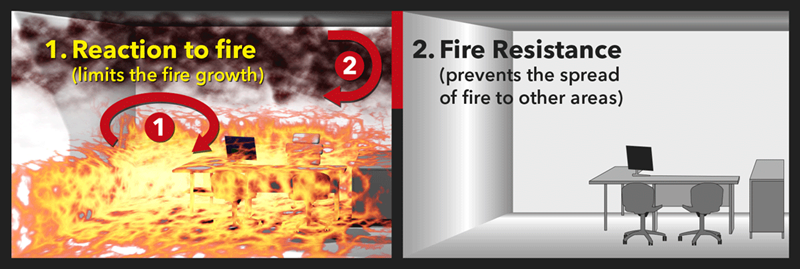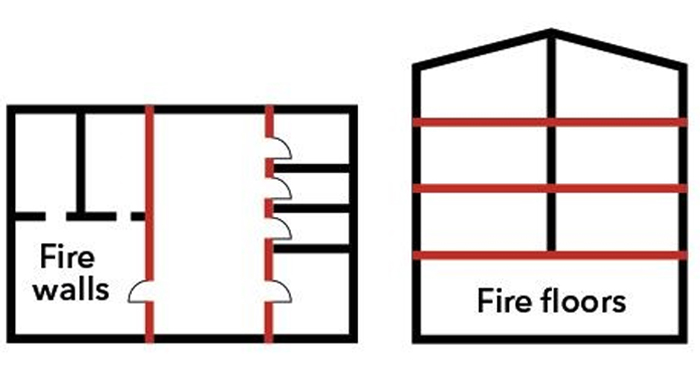Passive Fire Protection -an Important Element of any Fire Safety Strategy
Passive Fire Protection is an important part of fire safety, which in turn is a very important factor in constructing a safe building. Passive fire protection includes the total impact of the various measures which are planned and implemented in a building, and also those which are taught to the occupants of the building.
Because of the importance of fire safety, most countries have developed detailed legislation regarding fire-safe construction. This helps ensure that a comprehensive fire strategy is considered when a building is constructed, thus protecting people’s lives and helping to quantify losses in case of fire.
What is Passive Fire Protection?
Fire protection is an important part of any fire safety strategy and includes active fire protection (detection and suppression) and passive fire protection (structural fire protection and compartmentation).
Passive Fire Protection (PFP) is based on structural fire protection and compartmentation and allows safe exit of occupants out of the building and entrance of the fire brigade into the building.
Structural Fire Protection ensures the stability of structural elements (such as steel beams or columns, or timber beams or columns) in a building in case of fire. This is achieved by applying adequate products onto the structural element, such as boards, paints or sprays.
A Compartment is a defined space in a building which limits the spread of fire and smoke. The size and number of compartments are defined in all national building codes – dependent on the floor area or volume, and the amount of combustible materials on each level. Building codes differ from one country to another. Compartments are always vertical (fire-rated floors or ceilings) and horizontal (fire- rated walls). As all kinds of services are required in such boxes, certain openings are created, which then have to be protected again. An obvious and always visible services such as cables, pipes, ducts, etc., are running through a structure, the tightness of the compartment has to be ensured again by installing adequate penetration seals.
These penetration seals are mostly a combination of several products such as coatings, mortars, collars, wraps, sealants and backfilling material, and here the key question is how materials interact.
Fire Regulations
Any passive protection system is, of course, only as good as the installation process. In each country, relevant local fire building codes and legislation apply.
Fire Tests and REI

As all systems are fire tested, the result is a certain level of fire resistance, which is shown in a fire rating value. All test standards, EN, ASTM, BSand the like, define clearly how the fire rating has to be indicated in reports. The EN 13501 series defines the presentation of classifications according to the following template:
For load-bearing elements the applied load or load level is additionally included. For penetration seals and joints, additional elements are required, such as pipe end configuration for the penetrations and width for the joints.
Most important are the definitions of integrity (E), insulation (I) and load-bearing capacity (R) according EN 13501-2, Chapter 5.2.

Integrity (E)
This is the time in completed minutes for which the test specimen continues to maintain its separating function during the test without ignition of a cotton pad, or passage of a gap gauge, or sustained flaming.

Insulation (I)
This is the time in completed minutes for which the test specimen continues to maintain its separating function during the test without developing temperatures on its unexposed surface that increase the average temperature above the initial average one by more than 140 °C, or increase temperature at any location above the initial average one by more than 180 °C. In the case of small surfaces (such as joint seals), the average temperature rise is irrelevant, and thermal insulation means the maximum temperature (180 °C) only.
Load-Bearing Capacity (R)
This is the ability of the element of construction to withstand fire exposure under specified mechanical actions, on one or more faces, for a period of time without any loss of structural stability.

Fire Ratings
A fire rating of EI 120 means that the system will keep the tightness of the compartment in case of fire for the passage of flames (E) for 120 minutes, and also for the passage of heat and flames (I) for 120 minutes. A fire rating of E 120 and EI 90 would mean an integrity (E) – passage of flames – of 120 minutes, and insulation (I) – passage of heat and flames – of 90 minutes.

What is the difference between Fire Resistance and Rreaction to Fire?
Fire resistance is maintaining the structural stability or preventing the spread of fire from one compartment to another and is tested for every system.
Reaction to fire measures the material behavior per product and how it contributes to the growth of a fire. This is important in a hotel building, where furniture, curtains, carpets, etc., should be non-combustible or low combustible. Passive fire protection materials do not have to be non combustible, as their fire performance is proved in a fire test in the adequate system.
